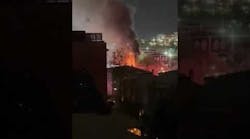Common Additives
MTBE - methyl tertiary butyl etherTAME - tertiary amyl methyl etherETBE - ethyl tertiary butyl etherDIPE - di-isopropyl etherEthanol and MethanolUp to now, the most commonly used additive has been MTBE. MTBE or methyl tertiary butyl ether, in the past a by-product of the fuel processing industry, and now under severe environmental scrutiny, remains present in fuels in levels from 15% up to 30% of total volume in many departmental jurisdictions.
The challenges to the fire service surface as these chemicals are more understood and dealt with in emergency situations. They are polar solvents, and as such, must be treated in a different way. As we have learned in the past, foam concentrates must be designed chemically and applied manually (Type III application) to work specifically on alcohol or polar solvent based fuels.
Because of its tremendous affinity for water, the alcohol tends to aggressively destroy the foam blanket and the potential vapor barrier you are trying to create because of the reduced surface tension of the fuel in relationship to the foam agent. The level of MTBE, or other additive, in a fuel related incident might require that the initial attack strategy to deal with vapor suppression or mitigation of a polar solvent fire be thoroughly reviewed.
Keys to Successful Vapor Suppression or Extinguishment of Blended Fuels
Use a UL Type III listed AFFF-AR (alcohol resistant) foam concentrate. If using a dual listed foam 3X6%, or 3X3%, use the highest mix ratio
The use of a multi-expansion foam attachment is necessary to create the following expansion ratios:
Practice gentle application techniques and avoid plunging foam into the fuel or disrupting the foam blanket after application
Survey local distributors and terminals within your jurisdiction for usage. The higher the level of alcohol or polar solvent the better the creation of the polymeric member that provides vapor suppression.
Never mix AFFF-AR foams with other foam concentrates. Application rates of 0.15gpm/Sq. Ft. are necessary for most blended fuel applications. (i.e. 95 gpm eductor can handle about 750 sq. ft.) Refer to NFPA 11 for application and support recommendations for incidents Involving a Flammable Liquid (Class B Fuel)
Hydrocarbons
Fuels that are mostly refined crude oil or vegetable matter. Will not mix with water.
AFFF - aqueous film forming foamFFFP - film forming fluoroproteinAFFF AR - Alcohol resistant AFFFProteinUnignited
May apply at less than rates for ignited. Be capable of increasing to ignited rates if necessary
Apply using Medium Expansion setting for vapor suppression
Ignited
Application rates in GPM/Sq.Ft.
- AFFF- FFFP 0.10
- Protein 0.16
- Fluoroprotein 0.16
- Reapply as necessary
Apply using Low Expansion setting for extinguishment
Polar Solvent
A flammable liquid that mixes with water. Examples are alcohols, amines, ethers, esters, aldehydes, and keytones. In firefighting, any flammable liquid, which destroys regular foams, is generally referred to as a polar solvent.
AFFF AR - Alcohol resistant AFFF
Unignited
Application rates should follow manufacturer's recommendations for handheld nozzles.
Apply using Medium Expansion setting for vapor suppression
Ignited
Application rates should follow manufacturer's recommendations for handheld nozzles. Apply using Low Expansion setting for extinguishment





